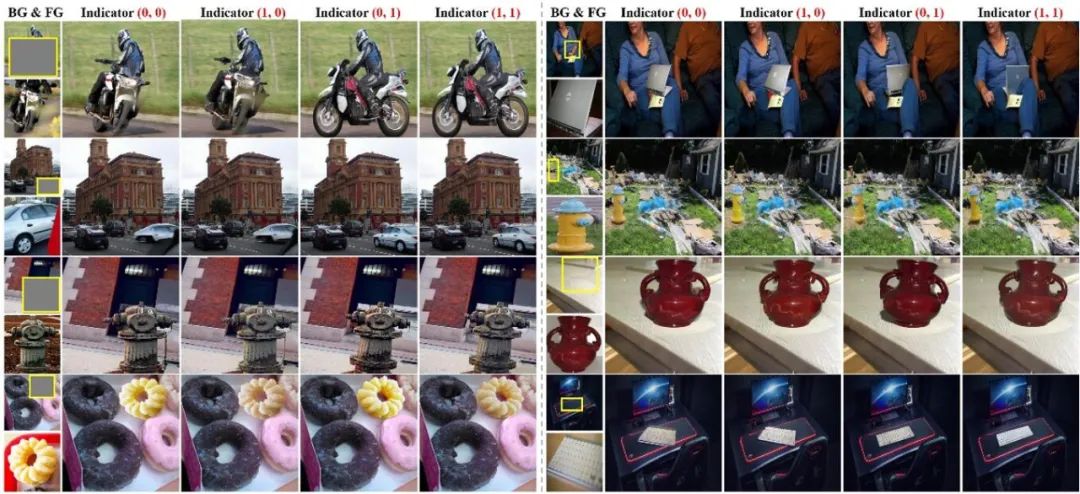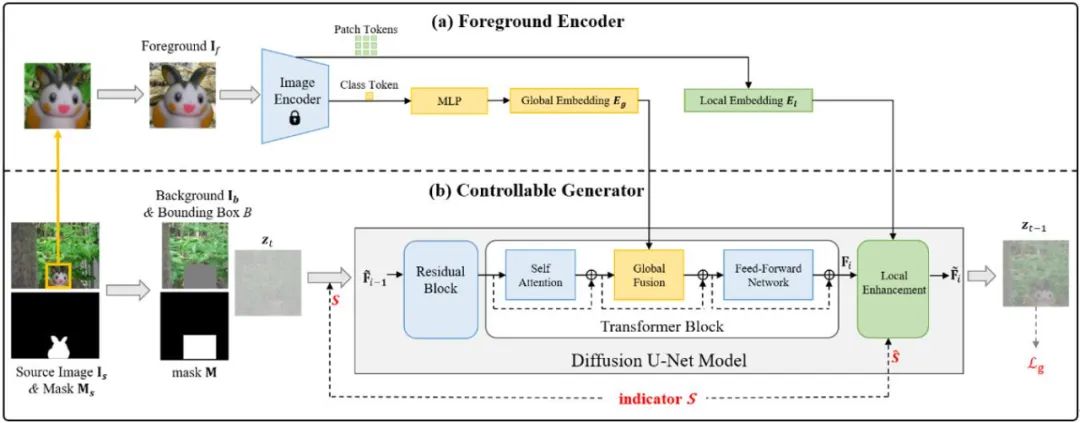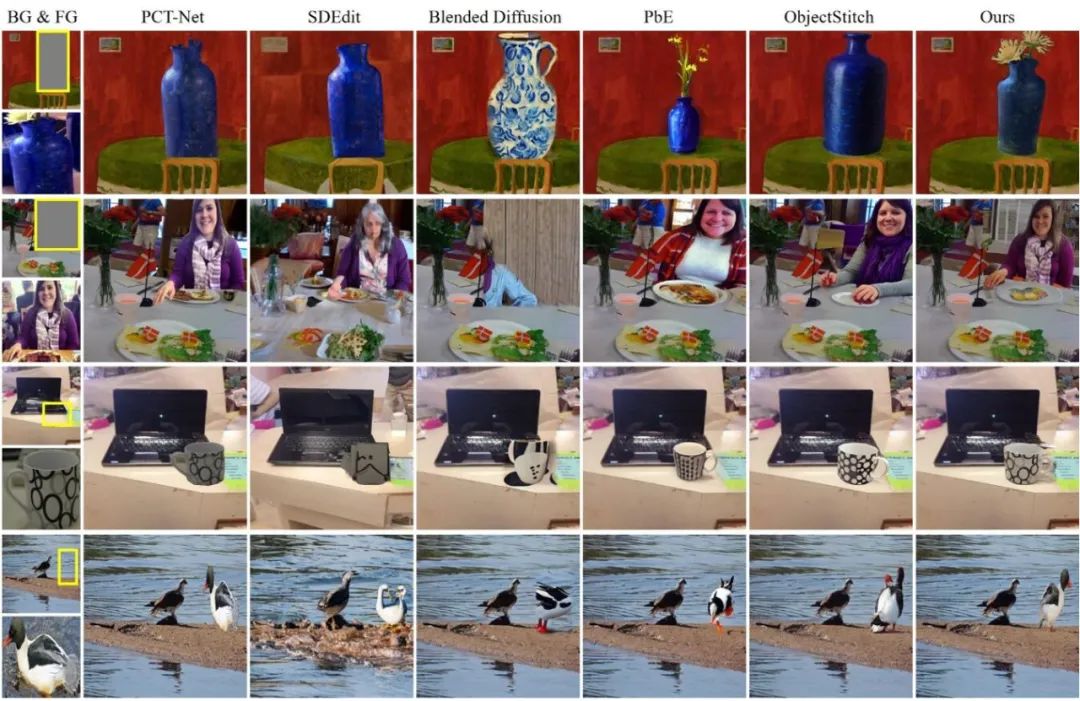 Technology peripherals
Technology peripherals
 AI
AI
 'Scene Control Portal: Four-in-one Object Teleportation, Submitted & Ant Produced'
'Scene Control Portal: Four-in-one Object Teleportation, Submitted & Ant Produced'
'Scene Control Portal: Four-in-one Object Teleportation, Submitted & Ant Produced'
In common image editing operations, image synthesis refers to the process of combining the foreground object of one picture with another background picture to generate a composite picture. The visual effect of the synthesized image is similar to transferring foreground objects from one picture to another background picture, as shown in the figure below

Image synthesis in artistic creation , poster design, e-commerce, virtual reality, data augmentation and other fields are widely used
The composite image obtained by simple cut and paste may have many problems. In previous research work, image synthesis derived different subtasks to solve different subproblems respectively. Image blending, for example, aims to resolve unnatural borders between foreground and background. Image harmonization aims to adjust the lighting of the foreground so that it harmonizes with the background. Perspective adjustment aims to adjust the pose of the foreground so that it matches the background. Object placement aims to predict the appropriate location, size, and perspective angle for foreground objects. Shadow generation aims to generate reasonable shadows for foreground objects on the background
As shown in the figure below, previous research work performed the above subtasks in a serial or parallel manner to obtain realistic and natural synthetic images. In the serial framework, we can selectively execute some subtasks according to actual needs
In the parallel framework, the currently popular method is to use the diffusion model. It accepts a background image with a foreground bounding box and a foreground object image as input and directly generates the final composite image. This can make foreground objects and background images seamlessly blended, lighting and shadow effects are reasonable, and postures are adapted to the background.
This parallel framework is equivalent to executing multiple subtasks at the same time, and cannot selectively execute some subtasks. It is not controllable and may bring unnecessary or unreasonable changes to the posture or color of foreground objects
What needs to be rewritten is:

In order to enhance the controllability of the parallel framework and selectively perform some sub-tasks, we proposed the controllable image composition model Controlable Image Composition (ControlCom). As shown in the figure below, we use an indicator vector as the condition information of the diffusion model to control the properties of the foreground objects in the composite image. The indication vector is a two-dimensional binary vector, in which each dimension controls whether to adjust the lighting attributes and posture attributes of the foreground object respectively, where 1 means adjustment and 0 means retention. Specifically, (0,0 ) means that it neither changes the foreground illumination nor the foreground posture, but just seamlessly blends the object into the background image, which is equivalent to image blending. (1,0) means only changing the foreground lighting to make it harmonious with the background and retaining the foreground posture, which is equivalent to image harmonization. (0,1) means only changing the foreground pose to match the background and retaining the foreground illumination, which is equivalent to view synthesis. (1,1) means changing the illumination and posture of the foreground at the same time, which is equivalent to the current uncontrollable parallel image synthesis
We incorporate four tasks into the same framework and implement a four-in-one object portal through indicator vectors function that can transport objects to specified locations in the scene. This work is a collaboration between Shanghai Jiao Tong University and Ant Group. The code and model will be open source soon
 Please click the following link to view the paper: https://arxiv.org/ abs/2308.10040
Please click the following link to view the paper: https://arxiv.org/ abs/2308.10040Code model link: https://github.com/bcmi/ControlCom-Image-Composition
In the figure below, we show the function of controllable image composition
 In the left column, the posture of the foreground object is originally adapted to the background image. The user may want to retain the posture of the foreground object. Previous methods PbE [1] and ObjectStitch [2] will make unnecessary and uncontrollable changes to the pose of foreground objects. The (1,0) version of our method is able to preserve the pose of the foreground object, blending the foreground object seamlessly into the background image with harmonious lighting
In the left column, the posture of the foreground object is originally adapted to the background image. The user may want to retain the posture of the foreground object. Previous methods PbE [1] and ObjectStitch [2] will make unnecessary and uncontrollable changes to the pose of foreground objects. The (1,0) version of our method is able to preserve the pose of the foreground object, blending the foreground object seamlessly into the background image with harmonious lighting In the column on the right, the lighting of the foreground object is supposed to be the same as the background lighting. Previous methods may cause unexpected changes in the color of foreground objects, such as vehicles and clothing. Our method (version 0.1) is able to preserve the color of a foreground object while simultaneously adjusting its pose so that it blends naturally into the background image

Next, we show more results for four versions of our method (0,0), (1,0), (0,1), (1,1). It can be seen that when using different indicator vectors, our method can selectively adjust some attributes of foreground objects, effectively control the effect of the composite image, and meet the different needs of users.

What we need to rewrite is: What is the model structure that can realize the four functions? Our method adopts the following model structure. The input of the model includes background images with foreground bounding boxes and foreground object images. The features and indicator vectors of the foreground objects are combined into the diffusion model
We re-extract the foreground Global features and local features of the object, and first fuse global features and then local features. During the local fusion process, we use aligned foreground feature maps for feature modulation to achieve better detail preservation. At the same time, indicator vectors are used in both global fusion and local fusion to more fully control the properties of foreground objects
We use the pre-trained stable diffusion algorithm to train the model based on 1.9 million images from OpenImage. In order to train four subtasks simultaneously, we designed a set of data processing and enhancement processes. For details on the data and training, see the paper

We tested on the COCOEE dataset and a dataset we built ourselves. Since previous methods can only achieve uncontrollable image synthesis, we compared with the (1,1) version and previous methods. The comparison results are shown in the figure below. PCTNet is an image harmonization method that can preserve the details of objects, but cannot adjust the posture of the foreground, nor can it complete the foreground objects. Other methods can generate the same kind of objects, but are less effective at retaining details, such as the style of clothes, the texture of cups, the color of bird feathers, etc.
Our method is better in comparison. Preserve the details of foreground objects, complete incomplete foreground objects, and adjust the lighting, posture and adaptation of foreground objects to the background

This work is for controllable This is the first attempt at image synthesis. The task is very difficult and there are still many shortcomings. The performance of the model is not stable and robust enough. In addition, in addition to lighting and pose, the attributes of foreground objects can be further refined. How to achieve finer-grained controllable image synthesis is a more challenging task
In order to keep the original intention Changes, the content that needs to be rewritten is: Reference
Yang, Gu, Zhang, Zhang, Chen, Sun, Chen, Wen (2023). Example-based image editing and diffusion models. In CVPR
[2] Song Yongzhong, Zhang Zhi, Lin Zhilong, Cohen, S. D., Price, B. L., Zhang Jing, Jin Suying, Arriaga, D. G. 2023. ObjectStitch: Generative object synthesis. In CVPR
The above is the detailed content of 'Scene Control Portal: Four-in-one Object Teleportation, Submitted & Ant Produced'. For more information, please follow other related articles on the PHP Chinese website!

Hot AI Tools

Undresser.AI Undress
AI-powered app for creating realistic nude photos

AI Clothes Remover
Online AI tool for removing clothes from photos.

Undress AI Tool
Undress images for free

Clothoff.io
AI clothes remover

Video Face Swap
Swap faces in any video effortlessly with our completely free AI face swap tool!

Hot Article

Hot Tools

Notepad++7.3.1
Easy-to-use and free code editor

SublimeText3 Chinese version
Chinese version, very easy to use

Zend Studio 13.0.1
Powerful PHP integrated development environment

Dreamweaver CS6
Visual web development tools

SublimeText3 Mac version
God-level code editing software (SublimeText3)

Hot Topics
 1389
1389
 52
52
 Breaking through the boundaries of traditional defect detection, 'Defect Spectrum' achieves ultra-high-precision and rich semantic industrial defect detection for the first time.
Jul 26, 2024 pm 05:38 PM
Breaking through the boundaries of traditional defect detection, 'Defect Spectrum' achieves ultra-high-precision and rich semantic industrial defect detection for the first time.
Jul 26, 2024 pm 05:38 PM
In modern manufacturing, accurate defect detection is not only the key to ensuring product quality, but also the core of improving production efficiency. However, existing defect detection datasets often lack the accuracy and semantic richness required for practical applications, resulting in models unable to identify specific defect categories or locations. In order to solve this problem, a top research team composed of Hong Kong University of Science and Technology Guangzhou and Simou Technology innovatively developed the "DefectSpectrum" data set, which provides detailed and semantically rich large-scale annotation of industrial defects. As shown in Table 1, compared with other industrial data sets, the "DefectSpectrum" data set provides the most defect annotations (5438 defect samples) and the most detailed defect classification (125 defect categories
 NVIDIA dialogue model ChatQA has evolved to version 2.0, with the context length mentioned at 128K
Jul 26, 2024 am 08:40 AM
NVIDIA dialogue model ChatQA has evolved to version 2.0, with the context length mentioned at 128K
Jul 26, 2024 am 08:40 AM
The open LLM community is an era when a hundred flowers bloom and compete. You can see Llama-3-70B-Instruct, QWen2-72B-Instruct, Nemotron-4-340B-Instruct, Mixtral-8x22BInstruct-v0.1 and many other excellent performers. Model. However, compared with proprietary large models represented by GPT-4-Turbo, open models still have significant gaps in many fields. In addition to general models, some open models that specialize in key areas have been developed, such as DeepSeek-Coder-V2 for programming and mathematics, and InternVL for visual-language tasks.
 Training with millions of crystal data to solve the crystallographic phase problem, the deep learning method PhAI is published in Science
Aug 08, 2024 pm 09:22 PM
Training with millions of crystal data to solve the crystallographic phase problem, the deep learning method PhAI is published in Science
Aug 08, 2024 pm 09:22 PM
Editor |KX To this day, the structural detail and precision determined by crystallography, from simple metals to large membrane proteins, are unmatched by any other method. However, the biggest challenge, the so-called phase problem, remains retrieving phase information from experimentally determined amplitudes. Researchers at the University of Copenhagen in Denmark have developed a deep learning method called PhAI to solve crystal phase problems. A deep learning neural network trained using millions of artificial crystal structures and their corresponding synthetic diffraction data can generate accurate electron density maps. The study shows that this deep learning-based ab initio structural solution method can solve the phase problem at a resolution of only 2 Angstroms, which is equivalent to only 10% to 20% of the data available at atomic resolution, while traditional ab initio Calculation
 Google AI won the IMO Mathematical Olympiad silver medal, the mathematical reasoning model AlphaProof was launched, and reinforcement learning is so back
Jul 26, 2024 pm 02:40 PM
Google AI won the IMO Mathematical Olympiad silver medal, the mathematical reasoning model AlphaProof was launched, and reinforcement learning is so back
Jul 26, 2024 pm 02:40 PM
For AI, Mathematical Olympiad is no longer a problem. On Thursday, Google DeepMind's artificial intelligence completed a feat: using AI to solve the real question of this year's International Mathematical Olympiad IMO, and it was just one step away from winning the gold medal. The IMO competition that just ended last week had six questions involving algebra, combinatorics, geometry and number theory. The hybrid AI system proposed by Google got four questions right and scored 28 points, reaching the silver medal level. Earlier this month, UCLA tenured professor Terence Tao had just promoted the AI Mathematical Olympiad (AIMO Progress Award) with a million-dollar prize. Unexpectedly, the level of AI problem solving had improved to this level before July. Do the questions simultaneously on IMO. The most difficult thing to do correctly is IMO, which has the longest history, the largest scale, and the most negative
 Nature's point of view: The testing of artificial intelligence in medicine is in chaos. What should be done?
Aug 22, 2024 pm 04:37 PM
Nature's point of view: The testing of artificial intelligence in medicine is in chaos. What should be done?
Aug 22, 2024 pm 04:37 PM
Editor | ScienceAI Based on limited clinical data, hundreds of medical algorithms have been approved. Scientists are debating who should test the tools and how best to do so. Devin Singh witnessed a pediatric patient in the emergency room suffer cardiac arrest while waiting for treatment for a long time, which prompted him to explore the application of AI to shorten wait times. Using triage data from SickKids emergency rooms, Singh and colleagues built a series of AI models that provide potential diagnoses and recommend tests. One study showed that these models can speed up doctor visits by 22.3%, speeding up the processing of results by nearly 3 hours per patient requiring a medical test. However, the success of artificial intelligence algorithms in research only verifies this
 To provide a new scientific and complex question answering benchmark and evaluation system for large models, UNSW, Argonne, University of Chicago and other institutions jointly launched the SciQAG framework
Jul 25, 2024 am 06:42 AM
To provide a new scientific and complex question answering benchmark and evaluation system for large models, UNSW, Argonne, University of Chicago and other institutions jointly launched the SciQAG framework
Jul 25, 2024 am 06:42 AM
Editor |ScienceAI Question Answering (QA) data set plays a vital role in promoting natural language processing (NLP) research. High-quality QA data sets can not only be used to fine-tune models, but also effectively evaluate the capabilities of large language models (LLM), especially the ability to understand and reason about scientific knowledge. Although there are currently many scientific QA data sets covering medicine, chemistry, biology and other fields, these data sets still have some shortcomings. First, the data form is relatively simple, most of which are multiple-choice questions. They are easy to evaluate, but limit the model's answer selection range and cannot fully test the model's ability to answer scientific questions. In contrast, open-ended Q&A
 PRO | Why are large models based on MoE more worthy of attention?
Aug 07, 2024 pm 07:08 PM
PRO | Why are large models based on MoE more worthy of attention?
Aug 07, 2024 pm 07:08 PM
In 2023, almost every field of AI is evolving at an unprecedented speed. At the same time, AI is constantly pushing the technological boundaries of key tracks such as embodied intelligence and autonomous driving. Under the multi-modal trend, will the situation of Transformer as the mainstream architecture of AI large models be shaken? Why has exploring large models based on MoE (Mixed of Experts) architecture become a new trend in the industry? Can Large Vision Models (LVM) become a new breakthrough in general vision? ...From the 2023 PRO member newsletter of this site released in the past six months, we have selected 10 special interpretations that provide in-depth analysis of technological trends and industrial changes in the above fields to help you achieve your goals in the new year. be prepared. This interpretation comes from Week50 2023
 The accuracy rate reaches 60.8%. Zhejiang University's chemical retrosynthesis prediction model based on Transformer was published in the Nature sub-journal
Aug 06, 2024 pm 07:34 PM
The accuracy rate reaches 60.8%. Zhejiang University's chemical retrosynthesis prediction model based on Transformer was published in the Nature sub-journal
Aug 06, 2024 pm 07:34 PM
Editor | KX Retrosynthesis is a critical task in drug discovery and organic synthesis, and AI is increasingly used to speed up the process. Existing AI methods have unsatisfactory performance and limited diversity. In practice, chemical reactions often cause local molecular changes, with considerable overlap between reactants and products. Inspired by this, Hou Tingjun's team at Zhejiang University proposed to redefine single-step retrosynthetic prediction as a molecular string editing task, iteratively refining the target molecular string to generate precursor compounds. And an editing-based retrosynthetic model EditRetro is proposed, which can achieve high-quality and diverse predictions. Extensive experiments show that the model achieves excellent performance on the standard benchmark data set USPTO-50 K, with a top-1 accuracy of 60.8%.



